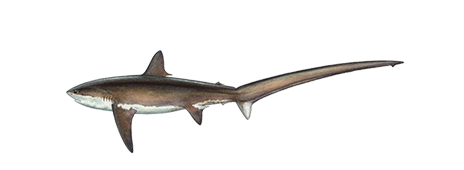
Thresher Sharks
<p>There is no record of a thresher shark ever attacking a person.</p>

Region
South, Northeast, West
Catch ease
Hard
Habitat
Ocean
HOW TO IDENTIFY A THRESHER SHARK
They are easily recognized because the upper lobe of the tail is usually as long as the rest of the body. The caudal peduncle lacks keels, the teeth are small and pointed with broad bases, and the skin is smoother than that of most other sharks. The longtail thresher and the pelagic thresher have moderate sized eyes (1.2-1.5% of the total body length). The first dorsal fin is located almost squarely in the middle of the back, well forward of the origin of the pelvic fins. The Atlantic and Pacific bigeye threshers have much larger eyes (2.8-4.1% of the total body length) and the rear margin of the dorsal fin is located at least as far back as the origin of the pelvic fins. The belly and lower flanks of this shark may be mottled.
WHERE TO CATCH THRESHER SHARK
The thresher sharks inhabit worldwide tropical, temperate and cold waters near the coasts and far offshore. The thresher shark species that can be found in the Pacific Ocean include the pelagic thresher shark and the Pacific bigeye thresher. In the Atlantic Ocean, the Atlantic bigeye thresher can be found and the longtail thresher occurs worldwide in warm to cool temperate zones. All of these species are generally pelagic though they do come in close to shore. The longtail and pelagic threshers occur near the surface and the bigeye threshers inhabit deep waters, their large eye undoubtedly aids them in seeing at greater depths. The following list includes additional details on where to catch this fish:
How to catch Thresher Shark
Threshers are a solitary species but it is not uncommon for them to congregate when large schools of bait fish are available and will occasionally hunt in pairs. Their diet is known to include mackerel, menhaden, garfish, needlefish and bluefish. Typically a thresher will slap or thrash the water with its tail to herd baitfish into a concentrated mass then use its tail to stun or injure individual fish before swallowing them. An angler may see his bait slapped out of the water then swallowed as it settles back in again, which is why threshers are often hooked in the tail. They are very active fighters when hooked and the longtail thresher has been known to leap clear out of the water. Fishing methods include trolling in marlin fashion or deep trolling and drifting, depending on the species to be caught. Whole baits, strip baits, live yellowtail snapper, or mullet may be used as well as feathers, or other baits or lures which are generally used for marlin or tuna. The following are fishing methods used to catch this fish:
Thresher Shark lures, tackle & bait
The following are lures, tackle or bait that can be used to catch this fish:
